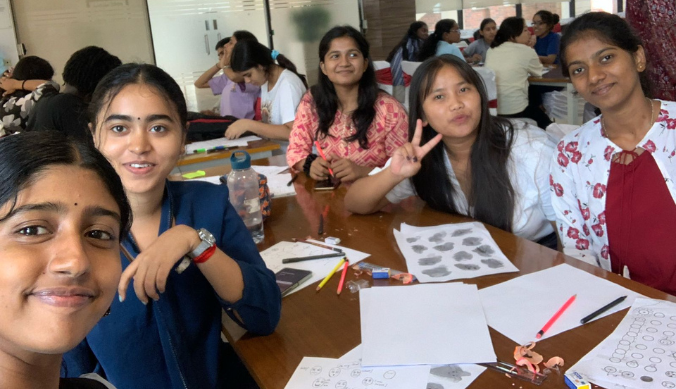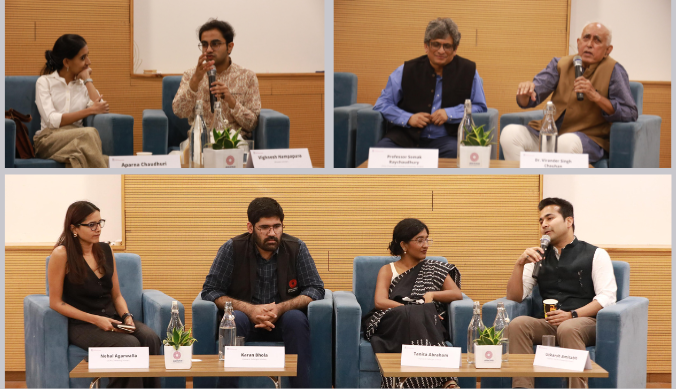Harnessing Skyrmions: The Future of Data Storage and Computation
Susmita Saha, Assistant Professor of Physics, Ashoka University, along with UG student Satwik Wats, delves into skyrmion-based devices, offering promising solutions for efficient, dense, and stable data storage.
As the world is becoming increasingly digital, the volume of data created daily is enormous, putting pressure on the current data storage technologies. To address this problem, scientists are searching for the next generation of data storage solutions, with skyrmions emerging as a promising candidate. Skyrmions are small swirling topological defects in the magnetisation texture, they are about a billionth of a meter in size and are very stable. Furthermore, they show particle-like behavior which allows us to manipulate their motion using electric current density or magnetic field. The advantages of skyrmion-based devices include improved energy efficiency, dense data storage, and non-volatility, making them a strong candidate for data storage in the future.
To explore the potential of this technology, Dr Susmita Saha, Assistant Professor of Physics at Ashoka University, aims to use skyrmions as key carriers of information and to perform computational tasks. This specific research is conducted by Mr. Satwik Wats, an Undergraduate Physics student of Ashoka University. In this work, skyrmions are represented as binary digits (1s and 0s) to perform basic logic operations and binary addition for 2-bit and 3-bit numbers. In Figure 1 below, the presence of a skyrmion represents 1, and its absence represents 0. The objective of the research is to create basic structures that would serve as the foundation for more complex circuits.

The research took inspiration from earlier works on skyrmion racetrack and AND/OR logic gates, but Dr Saha realised that the universal logic gate produced some non-trivial outputs that could not be addressed with the previous methods. To tackle this issue, Ashoka researchers explored the area of skyrmion-skyrmion interactions, discovering that the interaction behaviour exhibited peculiar results at different velocities. At low velocity, the two colliding skyrmions do not destroy each other and move in a circular path, whereas at high velocity, the skyrmions demolish upon collision. Moreover, the collision result depends on the parameters of the system, such as the Dzyaloshinskii-Moriya interaction (DMI), which is primarily responsible for the formation of the skyrmion. The researchers also observed that skyrmion-skyrmion interactions strongly depend on current density and the size of the skyrmion.

Using the results of skyrmion-skyrmion interactions, Dr Saha’s team successfully controlled the motion of skyrmions to construct universal logic gates, including NAND and NOR gates. The design of the universal logic gates is shown in Figure 2 (a) and (b). In this design, the researchers introduced a negative DMI in the form of a DMI barrier. They found that the presence of a DMI barrier is necessary for all the logic operations, as it provides more control over the interaction of skyrmions within the structure.
Furthermore, the team has implemented half-adder and full-adder circuits that can perform the arithmetic addition of two and three bits [see Fig. 2 (c) and (d)]. Binary digits called bits are the smallest unit of data that a computer system can process and store.
For this, they utilised the basic principles of skyrmion-skyrmion interaction, nucleation, and merging. The full adder is one of the most complex structures they have worked on in this paper. The successful construction and simulation of a full-adder circuit demonstrate the extent of manipulation that can be achieved using skyrmions.
The binary addition circuits (using skyrmions) bring researchers one step closer to building an arithmetic logic unit for the central processing unit, and the universal logic gates allow for cascading multiple such gates to perform more complex operations.
However, the findings extend beyond logic and computation operations alone. They offer techniques for manipulating and understanding skyrmion-skyrmion interactions, which could lead to numerous possibilities and intriguing simulations/experiments for skyrmionic applications in the future. With continued research, the potential applications of skyrmion devices are vast, and their topological protection is also attracting attention in the world of quantum computing.
– Edited by Dr Yukti Arora and Kangna Verma (Academic Communications, Research and Development Office, Ashoka University)
Reference Article:
Skyrmion Based Universal Logic Gates and Computation Operation, S. Wats and S. Saha, J. Phys. D: Appl. Phys. 57, 245001 (2024)
Authors: Satwik Vats and Susmita Saha
Study at Ashoka













